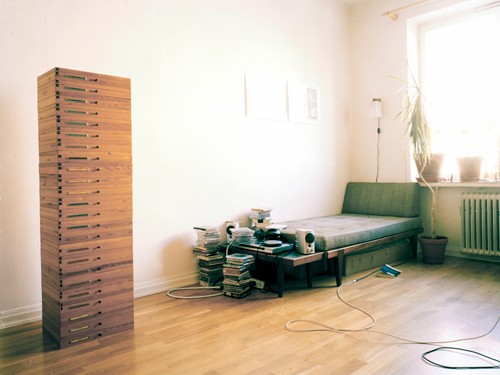
Photo: Maria Hedlund
The 1st at Moderna: Maria Hedlund
Life at Hyttödammen
1.6 2006 – 16.7 2006
Stockholm
Her method is that of a classic photographer, preferring a film-based camera to a digital one. She does not manipulate her photographs and she reduces post production to a minimum. At first glance, her subject-matter also appears to be somewhat conventional. She often depicts mundane objects taken out of a domestic context. On closer inspection, however, a sense of the unreal creeps over her images. Things are not only what they seem.
In 1997, Maria Hedlund received much attention and critical acclaim for a series of 13 photographs entitled At my Home (exhibited at Gallery Index in Stockholm). In 1998, she represented Sweden at the Sydney biennial with these images, which since have been exhibited at many international venues.
At my Home is a series of elegant, monochrome, white photographs of domestic objects and settings. Light switches, a computer keyboard, a kitchen fan, a section of a wall, bathroom tiles. What they have in common are signs of human presence: smudges of fingers round the light switch, a greasy patch on the wall behind the bed, encrustations on the bathroom tiles. The virginal, white surfaces have been soiled with the dirt of continued use. Over time, people have left their mark. Time has been made visible.
The marks of time and decay are also present in her series, Half Way (2002) which depicts a plant in the half way stage of decomposition, as well as in the diptych, Back into Nature (2003), showing decaying plants on a windowsill, and in the third body of work in this series, 16 images of plants in a sorry state, Deserted (2004).
Another body of work that received much attention was her large scale photographs of men’s shirts, Untitled (1998) and the following year in a smaller more intimate scale in Meditations. The extreme close-ups of men’s checked and striped shirts blur into optical illusions reminiscent of 60s Op Art. As in so many of her works, the presence of humanity is only hinted at. You do not actually see the wearers of the shirts, just as you do not see the people who forgot to water the plants or who pressed the light switches. But they are very much present, if only as an absence. There is a feeling of eeriness in some of her images, almost reminiscent of crime scene photos. Like a detective, or perhaps a forensic scientist, she provides us with clues left behind by people, inviting us to look closer and deeper, beyond the surface, into what is really happening.
Traces of prolonged human contact are also apparent on the chairs which form the subject matter for the series, Loosing Ground (2004). Photographed from above, one cannot see the legs of the chairs, only the seats and the back supports. They appear to be floating in the air. Indeed, after looking at them for a while, they begin to transform into something else. The shapes take on a new meaning.
This is typical of Maria Hedlund’s images. They are both familiar and evasive at the same time. They play tricks on the eye. They are often photographed from such an angle – extreme close-up or extreme long shot – that they do not reveal themselves at first, or, what was first revealed later becomes obscure. Her images question our seeing; they confuse our perception and make us uncertain as to what we are seeing and why we think we are seeing it. At times, she shows us the non-glamorous reality we do not want to see, and makes us aware that instability is a part of the everyday. Things can quite easily transform from one state to another. In a low key, matter of fact way she draws our attention to the glitch between reality and representation.
For the 1st at Moderna, Maria Hedlund presents a new work Life at Hyttödammen, a photographic installation based on an insect collection from the 1960s that she bought second hand some ten years ago. Collecting can be seen as an attempt to freeze a moment of time and preserve it for posterity. But collections are also subjected to the ravages of time. Maria Hedlund has meticulously recreated the 24 drawers of the insect collection, but left them closed, empty and redundant. The contents, the insects, exist now only as a set of twin photographs taken of each drawer: one with a glass cover and one with the glass removed. The images are presented as a slide show with the pictures fading into each other. The projectors, sculptural objects in their own right, emit an old fashioned sound uncannily similar to the buzzing of the absent insects.
Karen Diamond
Maria Hedlund
Born in 1961 in Västerås, Sweden. Lives and works in Stockholm and Malmö.
Education
1990-93 School of Photography and Film at Göteborg University.
Three solo exhibitions
2004
müllerdechiara, Berlin
2003
Gallery Magnus Åklund, Malmö
Sundsvalls Museum, Kulturmagasinet, Sundsvall
Three group exhibitions
2006
Time, Space and Disorientation, Borgovico 33, Como
Galleri F 15s Jubilee Exhibition, Moss
Eigenheim, Göttingen Kunstverien, Göttingen
The 1st at Moderna is an exhibition programme for contemporary art. The opening is always on the first day of the month, and the exhibitions are in different venues in or outside the museum.
